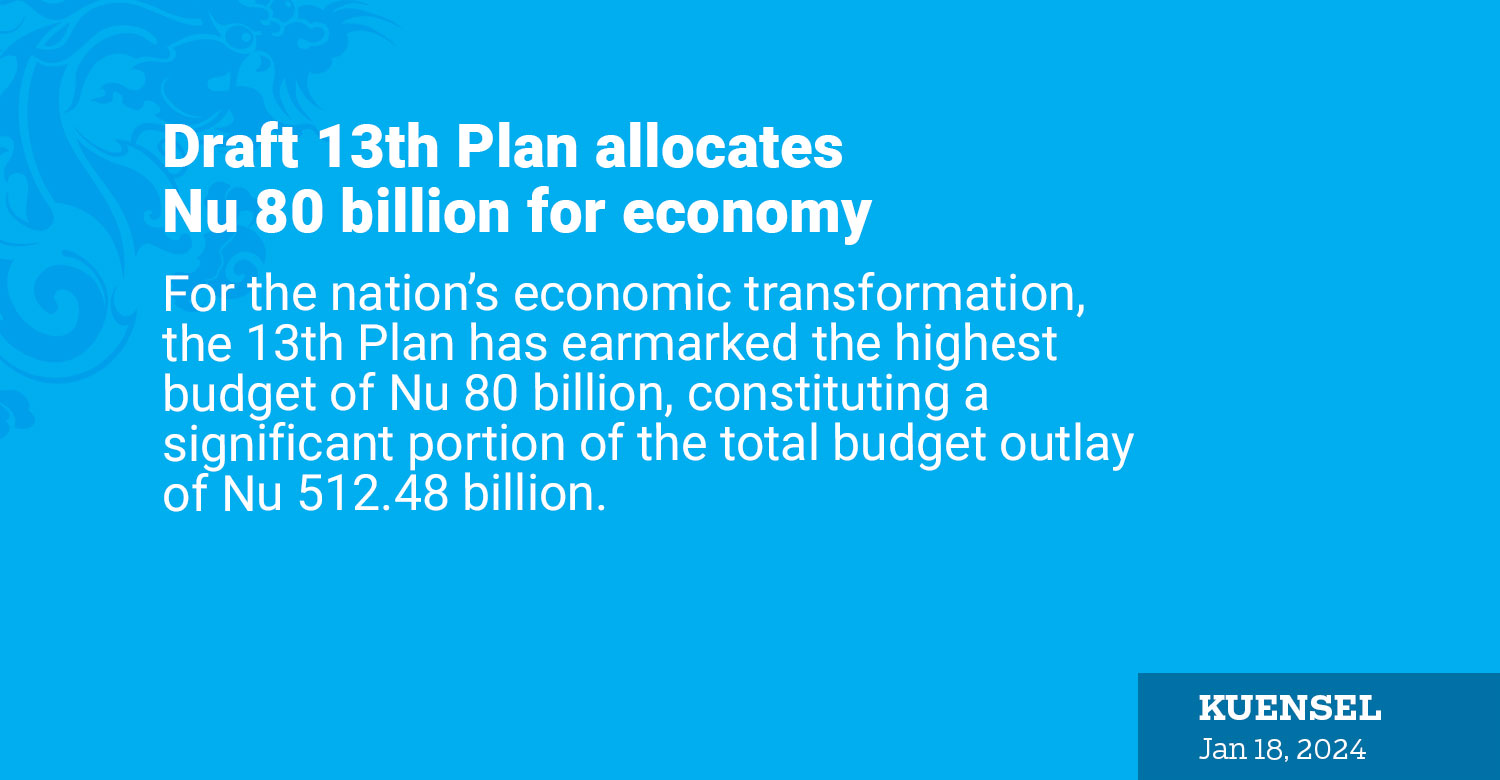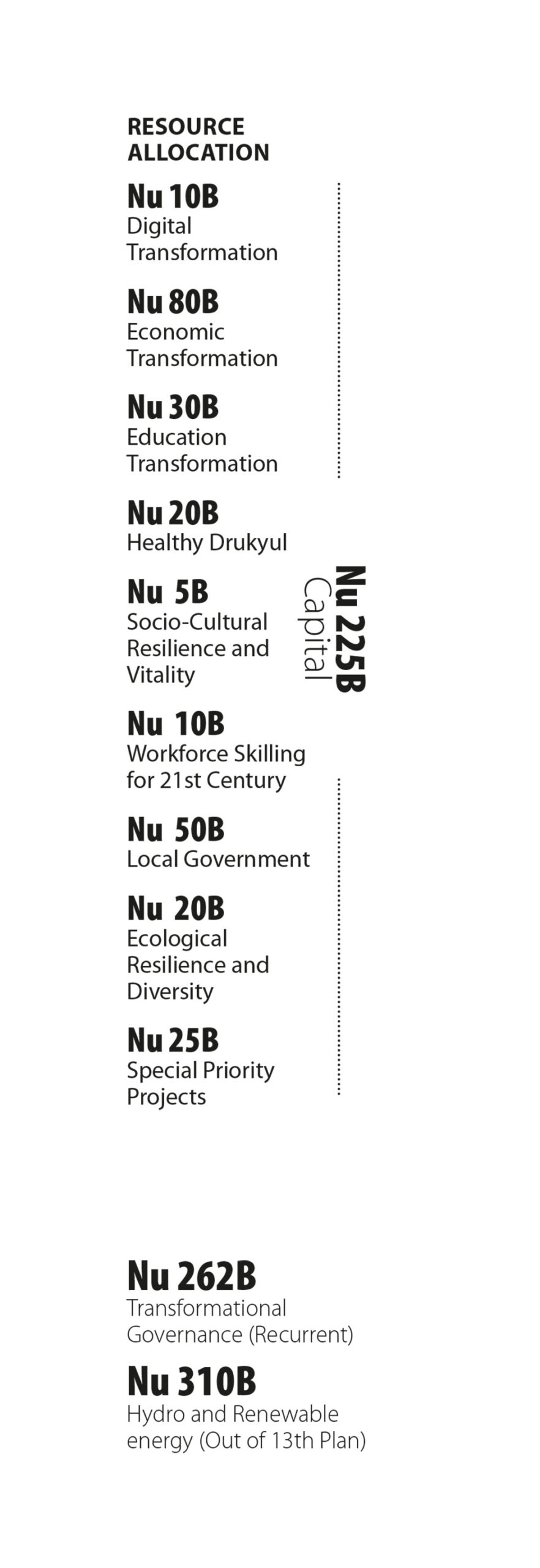
For the nation’s economic transformation, the 13th Plan has earmarked the highest budget of Nu 80 billion, constituting a significant portion of the total budget outlay of Nu 512.48 billion.
This plan, slated to commence from July of this year, sets ambitious goals, aspiring to elevate the country to a high-income status. The primary economic objectives include increasing the Gross Domestic Product (GDP) from USD 2.5 billion to USD 5 billion by 2029 and reaching USD 10 billion by 2034.
Simultaneously, the plan aims to boost GDP per capita from USD 3,833 to USD 4,256 by 2029 and surpassing USD 12,000 by 2034.
By 2027, the objective is to achieve full employment (97.5 percent) with quality jobs, and an income fourfold for the bottom 40 percent by 2029.

Out of the total budget, Nu 250 billion is allocated for capital, while Nu 262.48 billion is designated for current expenditure. Notably, the 13th Plan’s budget stands at 30 percent higher than the 12th Plan’s budget of Nu 394.84 billion.
Sources of funding include domestic resources totaling 318.89 billion and Nu 140 billion in grants, with contributions from the government of India (Nu 100 billion), EU, Japan, and multilateral agencies like the UN. An additional Nu 10 billion is allocated from green or climate financing, including the Bhutan Trust Fund for Environmental Conservation.
The fiscal deficit is estimated at Nu 53.59 billion, accounting for nine percent of GDP. Under domestic revenue, tax revenue is anticipated to be Nu 212.3 billion, accompanied by non-tax revenue of Nu 106.59 billion.
The draft stage of the 13th Plan is currently awaiting finalisation after the People’s Democratic Party assumes office on January 25.
The respective ministries will present their draft plans, encompassing projects, outputs, key performance indicators, major activities, cost estimates, fund sources, and modalities.
The People’s Democratic Party manifesto titled “13th Plan Plus 13 Pledges,” which was aligned to the draft 13th Plan is under review and the pledges analysis report would be presented to the new government for finalisation.
Agriculture and livestock
The draft Plan seeks to increase the GDP in agriculture and livestock to Nu 58,698 billion, targeting an economic growth rate of 8 percent. The objective is to create employment for 125,160 people, constituting 43.5 percent of total employment.
The plan envisions a 50 percent increase in agriculture output, a 10 percent boost in productivity, and a 10 percent rise in agriculture exports.
Allocations also include Nu 2 billion for concessional financing supporting commercial production of priority crops or livestock like rice, wheat, maize, poultry, pork, and avocado. and Nu 1 billion for small-sized concessional financing for subsistence farming.
An additional Nu 1.5 billion is earmarked for irrigation and water supply, exploring foreign direct investments, and initiating output subsidies.
Mining
The plan outlines a goal for mining, targeting a GDP increase to Nu 9,089 billion at a growth rate of 12 percent.
This sector aims to create additional 1,446 jobs, constituting 0.5 percent of the workforce, and increase the GDP share from mining to 15 percent.
Initiatives include exploring potential mines and minerals through a national-level scoping survey, mining ownership reforms, and enabling private sector participation in value-addition activities.
Tourism
The tourism sector aims to double government revenue, increase tourist arrivals by 150 percent to 473,398 from pre-pandemic levels, and generate an additional 30,000 jobs.
The plan proposes rationalising taxes, targeted interest rates for tourism product development, and introducing district and slab-based sustainable development fees.
Strategic infrastructure grants on a cost-sharing basis, operated by the private sector, are also planned. Workforce upskilling initiatives, including diverse language training, are part of the strategy.
Manufacturing
The draft Plan envisions increasing the manufacturing sector’s contribution to GDP to Nu 29,369 billion at a growth rate of 5 percent.
Objectives include a 10 percent increase in government revenue from the sector and the creation of 10,000 jobs.
Initiatives comprise making raw material inputs accessible, developing new modes of transportation, and offering grants or low-cost credit for start-ups, new product development, and upscaling.
Policy measures include relaxation of foreign direct investment (FDI) requirements and fiscal incentives.
Construction
The construction sector aims to increase its GDP to Nu 43,114 billion at a growth rate of 12 percent, creating an additional 2,000 jobs.
The plan emphasises the need for 70 percent of construction supplies to be domestic, establishing a domestic supply chain, and promoting FDI (joint ventures, and public-private partnerships).
Incentives for new efficient and green technology and concessional credit for construction using new technology are also proposed.
Digital economy
The digital economy sector targets the creation of 5,000 profitable digital entrepreneurs and the operation of 10 e-commerce trading platforms globally with a trading volume exceeding USD 10 million.
There are also plans to establish three additional data centres targeting export of services, cinema hall or theatre in every district, three state-of-the-art Studios (film production/art) in the country, and monetisation options instituted (payment gateways, digital currency).
Infrastructure development includes the South-North highway, Northern and Southern East-West highway, highways, bridges connecting dzongkhags, construction of new airports, upgrading existing airports, monorail systems, and water and ropeways.
The plan envisions allowing civil servant doctors to own and operate private clinics, concessional loans for highland businesses, and allocates Nu 50 billion as grants for local governments.
The 13th Plan also includes resource allocation to Sarpang and Gelephu Thromde as per resource allocation formula and simultaneous allocation of resources to essential preparatory infrastructure and services necessary for the development of Gelephu Mindfulness City.












